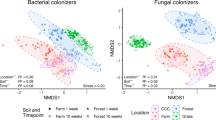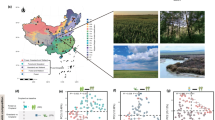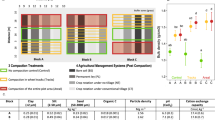Abstract
Although numerous studies have investigated changes in soil microbial communities across space, questions about the temporal variability in these communities and how this variability compares across soils have received far less attention. We collected soils on a monthly basis (May to November) from replicated plots representing three land-use types (conventional and reduced-input row crop agricultural plots and early successional grasslands) maintained at a research site in Michigan, USA. Using barcoded pyrosequencing of the 16S rRNA gene, we found that the agricultural and early successional land uses harbored unique soil bacterial communities that exhibited distinct temporal patterns. α-Diversity, the numbers of taxa or lineages, was significantly influenced by the sampling month with the temporal variability in α-diversity exceeding the variability between land-use types. In contrast, differences in community composition across land-use types were reasonably constant across the 7-month period, suggesting that the time of sampling is less important when assessing β-diversity patterns. Communities in the agricultural soils were most variable over time and the changes were significantly correlated with soil moisture and temperature. Temporal shifts in bacterial community composition within the successional grassland plots were less predictable and are likely a product of complex interactions between the soil environment and the more diverse plant community. Temporal variability needs to be carefully assessed when comparing microbial diversity across soil types and the temporal patterns in microbial community structure can not necessarily be generalized across land uses, even if those soils are exposed to the same climatic conditions.
Similar content being viewed by others
Log in or create a free account to read this content
Gain free access to this article, as well as selected content from this journal and more on nature.com
or
References
Altschul SF, Gish W, Miller W, Myers EW, Lipman DJ . (1990). Basic local alignment search tool. J Mol Bio 215: 403–410.
Ambus P, Robertson GP . (2006). The effect of increased n deposition on nitrous oxide, methane and carbon dioxide fluxes from unmanaged forest and grassland communities in Michigan. Biogeochemistry 79: 315–337.
Baldrian P, Kolarik M, Stursova M, Kopecky J, Valaskova V, Vetrovsky T et al. (2012). Active and total microbial communities in forest soil are largely different and highly stratified during decomposition. ISME J 6: 248–258.
Bates ST, Berg-Lyons D, Caporaso JG, Walters WA, Knight R, Fierer N . (2011). Examining the global distribution of dominant archaeal populations in soil. ISME J 5: 908–917.
Bergmann GT, Bates ST, Eilers KG, Lauber CL, Caporaso JG, Walters WA et al. (2011). The under-recognized dominance of Verrucomicrobia in soil bacterial communities. Soil Biol Biochem 43: 1450–1455.
Bissett A, Richardson AE, Baker G, Thrall PH . (2011). Long-term land use effects on soil microbial community structure and function. Appl Soil Ecol 51: 66–78.
Buckley DH, Schmidt TM . (2001a). The structure of microbial communities in soil and the lasting impact of cultivation. Microb Ecol 42: 11–21.
Buckley DH, Schmidt TM . (2001b). Environmental factors influencing the distribution of rRNA from Verrucomicrobia in soil. FEMS Microbiol Ecol 35: 105–112.
Buckley DH, Schmidt TM . (2003). Diversity and dynamics of microbial communities in soils from agro-ecosystems. Environ Microbiol 5: 441–452.
Butler JL, Williams MA, Bottomley PJ, Myrold DD . (2003). Microbial community dynamics associated with rhizosphere carbon flow. Appl Environ Microb 69: 6793–6800.
Caporaso JG, Bittinger K, Bushman FD, DeSantis TZ, Andersen GL, Knight R . (2010a). PyNAST: a flexible tool for aligning sequences to a template alignment. Bioinformatics 26: 266–267.
Caporaso JG, Kuczynski J, Stombaugh J, Bittinger K, Bushman FD, Costello EK et al. (2010b). QIIME allows analysis of high-throughput community sequencing data. Nat Methods 7: 335–336.
Clarke KR, Gorley RN . (2006) PRIMER 6th edn PRIMER-E Ltd.: Plymouth, UK.
Cruz-Martinez K, Suttle KB, Brodie EL, Power ME, Andersen GL, Banfield JF . (2009). Despite strong seasonal responses, soil microbial consortia are more resilient to long-term changes in rainfall than overlying grassland. ISME J 3: 738–744.
DeBruyn JM, Nixon LT, Fawaz MN, Johnson AM, Radosevich M . (2011). Global biogeography and quantitative seasonal dynamics of gemmatimonadetes in soil. Appl Environ Microb 77: 6295–6300.
DeSantis TZ, Hugenholtz P, Larsen N, Rojas M, Brodie EL, Keller K et al. (2006). Greengenes, a chimera-checked 16S rRNA gene database and workbench compatible with ARB. Appl Environ Microb 72: 5069–5072.
Edgar RC . (2010). Search and clustering orders of magnitude faster than BLAST. Bioinformatics 26: 2460–2461.
Faith DP . (1992). Conservation evaluation and phylogenetic diversity. Biol Conserv 61: 1–10.
Fierer N, Jackson RB . (2006). The diversity and biogeography of soil bacterial communities. Proc Natl Acad Sci USA 103: 626–631.
Fierer N, Bradford MA, Jackson RB . (2007). Toward an ecological classification of soil bacteria. Ecology 88: 1354–1364.
Frostegard A, Tunlid A, Baath E . (2011). Use and misuse of PLFA measurements in soils. Soil Biol Biochem 43: 1621–1625.
Gilbert JA, Field D, Swift P, Newbold L, Oliver A, Smyth T et al. (2009). The seasonal structure of microbial communities in the Western English Channel. Environ Microbiol 11: 3132–3139.
Grayston SJ, Griffith GS, Mawdsley JL, Campbell CD, Bardgett RD . (2001). Accounting for variability in soil microbial communities of temperate upland grassland ecosystems. Soil Biol Biochem 33: 533–551.
Griffiths RI, Thomson BC, James P, Bell T, Bailey M, Whiteley AS . (2011). The bacterial biogeography of British soils. Environ Microbiol 13: 1642–1654.
Huber JA, Butterfield DA, Baross JA . (2002). Temporal changes in archaeal diversity and chemistry in a mid-ocean ridge subseafloor habitat. Appl Environ Microb 68: 1585–1594.
Ives AR, Carpenter SR . (2007). Stability and diversity of ecosystems. Science 317: 58–62.
Jangid K, Williams MA, Franzluebbers AJ, Sanderlin JS, Reeves JH, Jenkins MB et al. (2008). Relative impacts of land-use, management intensity and fertilization upon soil microbial community structure in agricultural systems. Soil Biol Biochem 40: 2843–2853.
Jangid K, Williams MA, Franzluebbers AJ, Schmidt TM, Coleman DC, Whitman WB . (2011). Land-use history has a stronger impact on soil microbial community composition than aboveground vegetation and soil properties. Soil Biol Biochem 43: 2184–2193.
Kaiser C, Koranda M, Kitzler B, Fuchslueger L, Schnecker J, Schweiger P et al. (2010). Belowground carbon allocation by trees drives seasonal patterns of extracellular enzyme activities by altering microbial community composition in a beech forest soil. New Phytol 187: 843–858.
Kennedy N, Brodie E, Connolly J, Clipson N . (2006). Seasonal influences on fungal community structure in unimproved and improved upland grassland soils. Can J Microbiol 52: 689–694.
Knight R, Jansson J, Field D, Fierer N, Desai N, Fuhrman JA et al. (2012). Unlocking the potential of metagenomics through replicated experimental design. Nat Biotechnol 30: 513–520.
Knorr W, Prentice IC, House JI, Holland EA . (2005). Long-term sensitivity of soil carbon turnover to warming. Nature 433: 298–301.
Krave AS, Lin B, Braster M, Laverman AM, van Straalen NM, Roling WFM et al. (2002). Stratification and seasonal stability of diverse bacterial communities in a Pinus merkusii (pine) forest soil in central Java, Indonesia. Environ Microbiol 4: 361–373.
Kuczynski J, Liu ZZ, Lozupone C, McDonald D, Fierer N, Knight R . (2010). Microbial community resemblance methods differ in their ability to detect biologically relevant patterns. Nat Methods 7: 813–U867.
Lauber CL, Hamady M, Knight R, Fierer N . (2009). Pyrosequencing-based assessment of soil ph as a predictor of soil bacterial community structure at the continental scale. Appl Environ Microb 75: 5111–5120.
Lipson DA . (2007). Relationships between temperature responses and bacterial community structure along seasonal and altitudinal gradients. FEMS Microbiol Ecol 59: 418–427.
Lozupone C, Knight R . (2005). UniFrac: a new phylogenetic method for comparing microbial communities. Appl Environ Microb 71: 8228–8235.
Lozupone C, Lladser ME, Knights D, Stombaugh J, Knight R . (2011). UniFrac: an effective distance metric for microbial community comparison. ISME J 5: 169–172.
Lundin D, Severin I, Logue JB, Östman Ö, Andersson AF, Lindström ES . (2012). Which sequencing depth is sufficient to describe patterns in bacterial α- and β-diversity? Environ Microbiol Rep 4: 367–372.
Macdonald LM, Paterson E, Dawson LA, McDonald AJS . (2004). Short-term effects of defoliation on the soil microbial community associated with two contrasting Lolium perenne cultivars. Soil Biol Biochem 36: 489–498.
Paterson E, Gebbing T, Abel C, Sim A, Telfer G . (2007). Rhizodeposition shapes rhizosphere microbial community structure in organic soil. New Phytol 173: 600–610.
Placella SA, Brodie EL, Firestone MK . (2012). Rainfall-induced carbon dioxide pulses result from sequential resuscitation of phylogenetically clustered microbial groups. Proc Natl Acad Sci USA 109: 10931–10936.
Preston FW . (1960). Time and space and the variation of species. Ecology 41: 611–627.
Price MN, Dehal PS, Arkin AP . (2009). FastTree: computing large minimum evolution trees with profiles instead of a distance matrix. Mol Biol Evol 26: 1641–1650.
Ramirez KS, Lauber CL, Knight R, Bradford MA, Fierer N . (2010). Consistent effects of nitrogen fertilization on soil bacterial communities in contrasting systems. Ecology 91: 3463–3470.
Rasche F, Knapp D, Kaiser C, Koranda M, Kitzler B, Zechmeister-Boltenstern S et al. (2011). Seasonality and resource availability control bacterial and archaeal communities in soils of a temperate beech forest. ISME J 5: 389–402.
Rousk J, Baath E, Brookes PC, Lauber CL, Lozupone C, Caporaso JG et al. (2010). Soil bacterial and fungal communities across a pH gradient in an arable soil. ISME J 4: 1340–1351.
Schadt CW, Martin AP, Lipson DA, Schmidt SK . (2003). Seasonal dynamics of previously unknown fungal lineages in tundra soils. Science 301: 1359–1361.
Schimel J . (2001). Biogeochemical models: implicit vs. explicit microbiology. In: Schulze E, Heimann M, Harrison S, Holland E, Lloyd J, Prentice IC, et al (eds). Global Biogeochemical Cycles in the Climate System. Academic Press: New York, NY, USA, pp 177–183.
Shade A, Read JS, Youngblut ND, Fierer N, Knight R, Kratz TK et al. (2012). Lake microbial communities are resilient after a whole-ecosystem disturbance. ISME J 6: 2153–2167.
Smit E, Leeflang P, Gommans S, van den Broek J, van Mil S, Wernars K . (2001). Diversity and seasonal fluctuations of the dominant members of the bacterial soil community in a wheat field as determined by cultivation and molecular methods. Appl Environ Microb 67: 2284–2291.
Strickland MS, Lauber C, Fierer N, Bradford MA . (2009). Testing the functional significance of microbial community composition. Ecology 90: 441–451.
Wallenstein MD, McMahon S, Schimel J . (2007). Bacterial and fungal community structure in Arctic tundra tussock and shrub soils. FEMS Microbiol Ecol 59: 428–435.
Wu T, Chellemi DO, Graham JH, Martin KJ, Rosskopf EN . (2008). Comparison of soil bacterial communities under diverse agricultural land management and crop production practices. Microb Ecol 55: 293–310.
Zhang NL, Xia JY, Yu XJ, Ma KP, Wan SQ . (2011). Soil microbial community changes and their linkages with ecosystem carbon exchange under asymmetrically diurnal warming. Soil Biol Biochem 43: 2053–2059.
Acknowledgements
We thank Donna Lyons, Stacey VanderWulp, Kevin Kahmark, and Cathy McMinn for assistance with the sample collection and the laboratory analyses. In addition, we thank members of the Fierer lab group for their help with manuscript preparation. This work was funded by grants awarded to NF from the National Science Foundation (DEB-0953331) and the US Department of Agriculture (2008-34158-04713). Grants to JTL from National Science Foundation (DEB 0842441) and the US Department of Agriculture (2008-35107-04481 and 2011-67019-30225).
Author information
Authors and Affiliations
Corresponding author
Ethics declarations
Competing interests
The authors declare no conflict of interest.
Additional information
Supplementary Information accompanies this paper on The ISME Journal website
Rights and permissions
About this article
Cite this article
Lauber, C., Ramirez, K., Aanderud, Z. et al. Temporal variability in soil microbial communities across land-use types. ISME J 7, 1641–1650 (2013). https://doi.org/10.1038/ismej.2013.50
Received:
Revised:
Accepted:
Published:
Issue date:
DOI: https://doi.org/10.1038/ismej.2013.50
Keywords
This article is cited by
-
Bacterial community network complexity and role of stochasticity decrease during primary succession
Soil Ecology Letters (2024)
-
Land use conversion increases network complexity and stability of soil microbial communities in a temperate grassland
The ISME Journal (2023)
-
Effects of shining pondweed (Potamogeton lucens) on fungal communities in water and rhizosphere sediments in Nansi Lake, China
Community Ecology (2023)
-
Distinct and Temporally Stable Assembly Mechanisms Shape Bacterial and Fungal Communities in Vineyard Soils
Microbial Ecology (2023)
-
Bacterioplankton Assembly Along a Eutrophication Gradient Is Mainly Structured by Environmental Filtering, Including Indirect Effects of Phytoplankton Composition
Microbial Ecology (2023)



